|
To follow this study on The Jewish Cemeteries
in Budapest, I would give you a little geographical and historical
summary.
The river Danube ( Duna) runs through the middle
of Budapest, a metropolis of 1.7 million inhabitants, dividing the old royal
town Buda , Old Buda ( Ó-Buda) and the flat Pest plain.
The
area was inhabited 50,000 years ago, but took on today's name just 130 years
ago: until 1873, Óbuda, Buda and Pest were considered separate settlements.
ROMAN PERIOD
The earliest traces
of Jewish communities in Hungary dates back
to the 3th century.
This time the line of the river Duna (Fluvius Danubius or Ister) and the
western part of the today county under the name Province Pannonia had been
controlled by the Roman Empire. Beside of the Roman military contingent some
Jewish military legion soldiers and food supply commercials had been
appeared in Aquincum / today Óbuda.
 The earliest gravestone was designed for a roman
family with the death boy.
The earliest gravestone was designed for a roman
family with the death boy.
The stala was bought from an other Jewish family, engraving the family name
Béneiamin and the design of thee Menorah on it.
You can find these early Jewish stones (designed with Menorahs, other symbols,
like lulag, etrog, sofar and a nice writing: Heisz Theosz... The only one
God) in the historic collection of the Hungarian National Museum ( Magyar
Nemzeti Múzeum) BP. VIII.Múzeum krt. 14/15 open from 10 a.m- to 6 p.m every
day, except Mondays). The copy is exhibited in the Hungarian Jewish Museum (
Dohány str. Sinagogue II. floor). The
stone was bought by a Hungarian noble family, gr. Szapáry in 1830/40 and added
to their Alber-Irsa castle collection. The Jewish signs were discovered only in
1878.
HUNGARIAN FEUDAL KINGDOM
After an unexpected, devastating Mongolian attack
in the middle of the 13th century, the first citizens of the formal royal seat
town Esztergom, moved up the hill the western part of the river Duna. Later the
Royal Court was established on the north part of the hill, and with this began
the quite lengthy golden age of the new fortified city Castrum Budeaensi
, of the town Buda.
We
can detect the first signs of Jewish settlements in this area from the11th
century.
Jews were granted rights to liberty and freedom of worship by Béla IV after The
Tatar invan named in Latin language servus camerae from
1220.
The medieval Mint stood near Szt. György Square in The Buda Castle and The
first Jewish quarter was formed here on the so called Platea Judeorum or
Old Jewish Quarter.
The communitysion. They were renowned for being the treasurers and chamberlains of
the royal administratio built up the first Jewish Cemetery outside the
city walls, at the Ördögárok area, as Sepoltura Judeorum. The
earliest grave stone is dating back to 5038 ( 1278 ) with the name: R(av)
Peszah b(en) r(av) Peter. It was brought to light in 1894 from the today Alagut
utca and Pauler utca corner ( Buda, I. district).
The Jewish were several time expulsed out from
Buda, in 1348, 1360. They
could return beck in 1364, but their quarter was already occupied from other
citizens, so they could get a new area in the North of the Castle Hill, near to
the former Magna Curia Regis (Kammerhof), today the area of the Bécsi kapu tér
( Vienna Gate square). They started the new life with privileges of Jewish
authorities, like index Judeorum titus Regui, court of justice and Praefectus.
Buda was overruled by the Ottoman Turks and the city Buda was turned into a
Turkish town. From 1541 the Jewish could return to their town and under the
name Jahudiler Mahalleszi the Jewish quarter started to return into the normal
commercial and religious life. In the 16 th century more than 60 families used
to live in a peaceful period with the free independent organisation of the Jewish
court (kethüda in Turkish). The community had been used a New Buda
Cemetery at the +Viziváros ( Watertown), today at the BP. I.
Hunfalvy and Batthány utca. The former Jewish cemetery could not be used,
because of the mixed entombed Hungarian, Turkish and Jews died in the war of
the Turkish occupation.
In the 1686 recaptured war, the Jewish and Ottoman enemies were killed or taken
in hostage ( 274 Jewish person, paid and freed from the Prague Jewish
community). This is registered in the Megillah Oven. The died Jewish bones were
gathered and entombed in the BP. X. Kozma utca Jewish Cemetery at the Martyr
Plot in 1968 on the Pest side.
At
the former prefects house Mendel, we can find the Small Synagogue ( today
Middle-aged Jewish Synagogue Museum, +Középkori Zsidó Zsinagóga Múzeum BP. I.
Táncsics Mihály u. 26). On the left , inside the entrance there is a small
lapidarium exhibition of the Jewish gravestones of the First and New Buda
Cemeteries.
 Old gravestone at the entrance of Középkori Zsinagóga Múzeum.
Old gravestone at the entrance of Középkori Zsinagóga Múzeum.
When
Buda was recaptured from the Turks in 1686, the Jews were expelled.
Ó-BUDA (Old Buda) near today's Árpád
bridge ( Buda North ). By Jews called Ofen Jasan
For the forbidden to establish Jews in the royal free
towns, at the countryside, like near to the Buda Royal city gates, the landlord
noble Zichy family could settle down the good tax playing and working Jews,
arriving mostly from the Czech Moravian country.
In the 18th century they helped to create a flourishing industrial city in
Ancient Buda (Óbuda) and near today's Árpád bridge with famous dyeing workshops
and a textile factory established by the reputed Goldberger family.
The late
18th century witnessed the birth of new Jewish communities in Pest and the then
largest synagogue in the world was constructed between 1854 and 1859 on what
is(Óbuda) and near today's Árpád bridge with famous dyeing workshops and a
textile factory established by the reputed Goldberger family.
From the 18th centuries Old Buda become a Jewish centre under the name Ofen
Jasan/ Alt Ovn. In 1822, the inhabitants of Old Buda totally 7356 persons, 3210
were of the Jewish community. Shops, small industrial and craftsman workshops
characterized the today III: Lajos utca area. Famous dyeing workshops and a
textile factory established by the reputed
Goldberger family ( III. Lajos u. 138). The Goldberger Textile Factory
imported their products, blue painted textile in 50 other states and gave work
for 450 people. Leo Goldberger, already member of the High Court in the
Hungarian Parliament, died in the death camp in Mauthausen.
They had four cemeteries:
BP. III. Laktanya utca/ Kő utca area from
1831 till 1870. Today modern block flats are standing at the place.
BP. II. Pálvölgyi ( Szépvölgyároki)
cemetery: from 1820-1938. No sign of the former cemetery today.
Táborhegyi ( BP.III. Bécsi út-Labanc
utca): till 1888. No sign of the former cemetery today
Külső Bécsi út ( BP. III. Bécsi út 369) ,
the today Jewish cemetery of Óbuda.
BUDA side
of Budapest
ÓBUDA JEWISH CEMETERY
Address: BP. III.
Külső Bécsi út 369.
Photos taken by The author on June 2002.
Established: in 1922 by the Óbuda Jewish community and opened from the 31 year
old rabbi dr. Schreiber Ignac. He was unfortunately the first engraved Jew in
this cemetery, because he was hit 3 days later by a car.
Other important graves:
- Moses Münz rabbi, he was the
community leader until 1831.
- A newly cleaned monument was erected for the
149 killed patients in The Maros utca Jewish Hospital. Nazi Hungarians killed all the people in beds and the
doctors, nurses on 21 th January 1945.
- Gravestone for the victims of the Hungarian Holocaust: the last operation of
Adolf Eichmann to collect Jewish
people for the “Fussmarsch”, to march in the direction of Vienna for forced
works. The cemetery is already used for the
services today.
Pictures from the Óbuda Cemetery

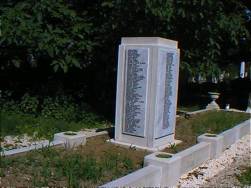
Gravestone
for the victims of Maros utca Jewish hospital
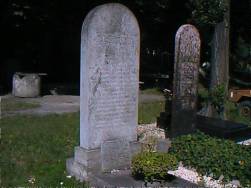
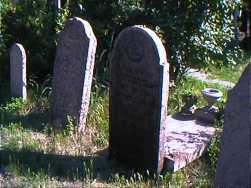
Gravestone
of rabbi Schreiber Ignác
Gravestone of rabbi Münz Mózes
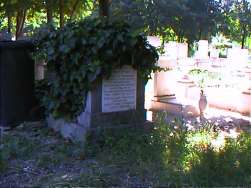

Gravestone for the Torahs. Victims of
the Óbuda Brick factory
Csörsz
utca Orthodox Cemetery
Address::
BP. XII. Csörsz utca 55
Photos
taken by the author Illés András on
June 2002.
This
cemetery is one of the oldest cemetery of Budapest, of the orthodox Jews in
Buda.
It
is hidden behind a high brick wall and you have to ask for the coming of the
caretakers of the Orthodox community. The size of the cemetery is 100 x 10 m,
we enter at the gate of a small out of use pre-burial house. The number of the
gravestones are 1360 and a small central road separate the section of men and
women.
Famous
graves:
-
Reich
Jaakov Koppel orthodox Buda chef rabbi of Buda, died in
1929.
- Chaim
David Szofer: a family member of the 18 th sanctuary
rabbi of Pozsony.
- Fraudiger
Mózes: the founder of the Óbuda Textile Factory.
-
Mautner
family grave
- Deutsch
family grave
- Grave
of the victims of the Maross utca Jewish Hospital murder in 1945.
Pictures
from the Csörsz utca cemetery
 

Farkasrét
Jewish Cemetery
Address:
XII. Érdi u. 9.
Size of
cemetery: 2,8 hectares with 2500
gravestones.
Photos
taken by the author Illés András on
June 2002.
The Jewish cemetery was established in 1885. The oldest known gravestone dates
from 1897.
The second biggest cemetery, after the cemetery of Óbuda. At the entrance from
the end-station of the trams, you will find a pre-burial house, helpful
caretakers could show you the old register book and a map of the cemetery.
Noted
persons:
Goldberg Rafael rabbi, Geyer Artur, Heller Bernát, Kiss Arnold,
Benoschofsky Imre and the former rabbi of Buda.
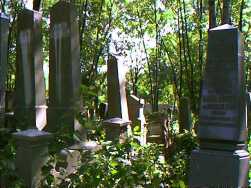

Graves from the cemetery Grave of the
architect Vágó László


Grave of the former rabbi of Buda Gravestone of dr. Képes Gyula
first member of the North Pole Expedition in 1872-73.


Gravestone of the fames composer
gravestone of
dr. Szabolcsi
Zsüti

Preparation
table
Pest
side
The history of the city of Pest was started
later.
Some document had been found, where in 1406 a Jewish man, called Saul asked for
the copy of the Jewish Lows, edited by the king Béla the IV.
Some Jewish houses stood already on the Pest side in 1504, but it was not
possible to live with the catholics
inside the city walls. The first houses were built up outside in the
former Lipótváros and Terézváros area.
The Jews travelled every day from Óbuda here, outside the walls had been the
State Markets ( at the place of the Erzsébet tér). They could rented rooms,
warehouses in the later built Orczy House, that become the cultural and social
centre of the Jewish. Café houses, synagogues, 120 flats and many warehouses
were built inside.
The Habsburg authorities issued in the name of the emperor Jozsef the II. the
deregulation laws: Gentis Judaical regulatio, De Judaeis memorandum a, to
cancel all the forbidden laws.
After some year of hesitation the local city counsel permitted to settle down of the Jews from
1786.
The population ground up from 1787 ( 81,000
Jews) to 1840 up to 239,000 Jewish inhabitants. That was the golden period for
emancipation and acceptation. For 1849, when the revolutionary government
recognised the Emancipation Laws, from the whole country inhabitants 5% were of
Jews, in PestBuda of 20%. The emperor Ferenc József issued the well awaited
acceptation laws in 1867. For the beginning of the 20 th sanctuary there were
900,000 Jews in big size Hungary, 93% of them were inhabitants of the united
tree towns born under the name Budapest.
The urban life helped for the forming
by Jews an intellectual segment of the sociality: literature, music,
literature, theatre and cinema, banking sector, large industrial companies and
European commercial organisations.
The young Theodor Herzl was born here, for 6 th of September 1859 here was
built the largest synagogue of the World, the Dohány utca ( Tobacco str.)
Synagogue.
Hungary collapsed into ruins after the I.
WW on beside of Austria and Germany. The country had lost 71% of her territory,
13 million of her inhabitants and also the half of the Jews.
In the same year, Hungary bought in the first anti-Jewish laws in
Europe (numerous Clauses) and has actively sought revenge for its lost
territories by aligning itself with the burgeoning nazi movement in Germany.
The
oldest Jewish cemetery on the Pest side was established in the 18th century.
The location had been somewhere in Kőbánya ( BP. X. district), at the so called
area of Újhegy ( New mountain).
Later,
about 200 years after, a new inside the city cemetery was opened at the
catholic Váci út cemetery, today at the Vámház kőrút.
Salgótarjáni út Jewish Cemetery
Address: BP. VIII.
Salgótarjáni út
Photos taken by The author Illés András 0n June 2002.
The
Salgótarjáni út Jewish cemetery was established in 1874 from a separate
territory in the 55 hectares of The New Public Cemetery ( Új Köztemető) of
Kerepesi Road formed in 1847.
The entrance was built from the Salgótarjáni út in a special architect form,
like The entrance of a castle, designed by the famous architect of this period,
Lajta Béla in 1908.
The entrance building includes the function rooms, the caretaker's flat as
well.
The whole cemetery
become place for the elite, for The
famous artists, for the gait family dynasties, for the banking and industrial
leaders of the liberal and in the society incorporated neology leaders.
At the entrance going ahead we can find , like in a jungle , a superb
wild vegetation.
The former pre-burial house, decorated with oriental-Mesopotamian style
relief's, is abandoned and the roof is collapsed down for a long time.
This exotic and wild green jungle style park gives interesting atmosphere to
the cemetery.
The last burials were in the years of 1950.
The important family graves:
Baron Weiss Manfréd and family crypt
The important industrial owner in
Csepel Steel Factory died in 1922. His activity gave a general speed up of the
country's industry and during the I.WW. the steel and army factory gave
employment to 30,000 workers. In 1880 he and his brother established the
Hungarian tin box and bullet cartridge case production. The factory moved in
1892 to the Csepel Island and become one of the biggest army suppliers of
the Monarchy.
Other family members rest in the family crypt: Wahl Albert railway company
president, Weiss Alice to whom memory they established the Budakeszi Pulmonary
Sanatorium. In 1944, after the German occupation, the owners were forced to
sell the ownership of the steel industry to the Germans and the family members
could live the country in the deal Jews airplane, organised by Rudolf Kasztner.
-Ulmann Adolf
President of the industry and monetary
political leader Hungarian General Credit Bank.
- Goldberger textile factory owner family
from Óbuda
The
Goldberger family established
1784 in Óbuda the most important textile industry. The company was so
important, that also the Emperor Ferenc József gave a visit there and become
later the textile supplier of the Monarchy. They had commercial partners and
depot in 50 countries. For 1867 become noble and member of the high political
elite. Leo Goldberger, the last member of the dynasty was transported in the
death camp of Mauthausen and died of hunger in the last days of the II. WW.
Ehrenfeld
family
the nice crypt is
worth to visit for the special mosaic decorations
Sváb family
crypt
The
grave is decorated with interesting black granite birds,
masterwork of the architect Lajta Béla.
Bródy
József and family crypt
The
black marble columns decorates the crypt.
He was the president of the Pest Chevra Kadisa corp.
Hatvany-Deutsch
family crypt:
The monumental
grave is in Greek Pantheon style realisation. The family was an important
patron and collector of fine arts. He established the Hatvan flour milling
industry and the private income of the business was invested in acquire
European value paintings. Following the promulgation of the Anti Jewish Laws,
all his collection was expropriated by the local authorities and kept under
national control. The paintings were transported in the famous golden train at
the last moment of the war out of the Russian army.
Aschner Lipót
General director of the Egyesült
Izzó Tungsram Incandescent Lamp Factory.
Friedmann
Bernát
lawyer
and ex counsel for the defence for the blood- trial against the Jews, 1882 in
Tiszaeszlar village.
Graves
of the Jewish victims in the period of the II. WW.
Victims of the battle of liberation of
Budapest and victims having suicided into the Danube river during the nazi
terror,
Victims of the last Budapest
Ghetto in Klauzál tér.
Stone
monument for 1500 victims, inaugurated on July 2002.
Address: BP. X. Kozma u. 6. Tel: 262-4687
Photos taken by the author
Illés András on July 2002.
The Jewish community received a large area from the city
administration in 1868 from the territory of the Rákoskeresztúr Public
Cemetery. The cemetery was planned by
architect Freud Vilmos.
Between 1905 - 1910 a geat number of Jewish were
exhumed and transported in this new cemetery by the Pest Chevra Kadisa.
The following brief description is that of the largest
existing Jewish cemetery in Budapest, where more tan 300,000 Jews have been
buried: The entrance is decorated in
white and forms part of a major building complex. The function rooms, central
preparation halls, offices and ceremony halls are separated for men and women.
The building was designed by the architect Freund Vilmos in 1891. During the
past decades, this cemetery become also the central cemetery of the Jewish
inhabitants of Budapest.
Important sights:
-At
the inside wall of the entrance building you can find a memorial
monument for the 10,000 Jewish
Hungarian soldiers, died during WWI.
-Military monument of the volunteer soldiers
of the revolution of 1849 ( design by Lajta Béla).
-Monument for the martyrs of the Hungarian Holocaust, realised by the
famous Hungarian olympic champion and architect Hajós Alfréd ( he was the first Hungarian olympian to win a gold medal).
-The large white walls and columns-pillars holds the names of all of the victims
(some hand-written entries complete the list) and here are buried 2,000 victims
of the Klauzál tér ghetto from the last months of WWII.


Pictures of the Holocaust
Monument
-Plot for the Martyrs:Monument of Jewish forced labourers
decorated with a big Torah
( Inscription: “ This company of 196 workers, marching back from the battle of
Volga river in Russia, were all murdered on 11th October 1944 in Kiskunhalas.)
-Monuments to the heroes of the
resistance fighters:


5/c
plot 3/23. Here was buried Miss Szenes Hanna ( 1950-ben exhumed in
1950 and brought
to Israel as a national heroin).
We can find here a 2 m high memorial column, remembering her.
To the right, in the 1. and 2. plot:
Rózsavölgyi Gyula music editor
Bársony Dóra opera singer
Szomory Dezső writer
Salamon Béla theatre actor
Goldziher Ignác Orientals
researcher, philologist
In
front, in the no. 10 plot: here rest the rabbis.
Oppenheimer Simon ben Dávid gravestone (he was living for 100 years),
died in 1851.
He was called miraculous rabbi, we can find a lot
of piece of visiting-sign stones and kvitli papers.

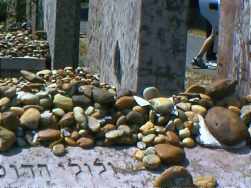
Grave of the wonder rabbi
Oppenheimer Visitor's signs on the grave


The gravestones of the
rabbis Main
building
Other graves of famous Hungarian
Jews:
Komjádi Béla architect, key figure of the Hungarian water-polo
Hajós Alfréd architect, the firs Olympic gold medal winner for
Hungary
Baumhorn Lipót architect, the most respected architect of the Hungarian
Synagogues. In Budapest: Csáky and Páva
str. synagogues, in countryside: Szegedi Nagyzsinagóga, Györgyös,
Brassó, Esztergom, Kaposvár, Cegléd, Kecskemét, Szolnok, Eger,
Liptószentmiklós, Temesvár, Fiume, Nagyszombat, Nyíregyháza, Losonc, Nagybecskerek,
Újvidék, Nyitra, Újpest synagogues.
(photo attached see below)
Lajta Béla
(Leitersdorfer Béla) sculptor, famous designer of a lot of family crypts (
photo see below)
Rózsavölgyi Márk
violinist and music composer, father of the Hungarian verbunkos folclore music.
(photo see below)


Hajós Alfréd's grave, 1955+ Grave of Komjádi Béla 1933+
Other well known Jews:
Róna József sculptor
Bródy Sándor playwright
Forrai György music composer
Selényi Pál research physicist
Wittmann Viktor aviation pioneer
Kellér Andor writer and Kellér Dezső actor,
Fehér Klára writer
Gózon Gyula actor ( statue by Varga Imre)
Szép Ernő writer
Hajós Alfréd architect ( central sport swimming pool on the Margaret Island)
Kishegyi Árpád opera singer (modern Menorah design)
Extremely important crypts:
Blockner family crypt
Brüll family's crypt ( outside with lions, inside with mosaics
decoration)
Gerster Kálmán and Sróbl Alajos graves ( MTK sport club's financial
directors)
Hay family's crypt ( in secession style)
Schmidl mausoleum ( designed by Lajta Béla) decorates with the
Zsolnay ceramics and mosaics. Renovated, see on photo.
Goldberger Berthold's crypt in secession style
( History of the family
see at Óbuda textile factory)
Wellisch family crypt ( see photo)
Kornfeld Zsigmond bank-and stock exchange bank director's grave
Heidelberg family's grave ( nice wrought iron gate)
Griesz family crypt (designes by Lajta Béla) lions figures, inside mosaic
cupola ( see photo)
Redlich-Ohrenstein gravestone ( designed by Alpár Ignác, the same of the Parliament
house)
Urbán family grave
Lichtenstein Samu grave (art deco)
Hüvös József grave ( Egyptian design elements)
Halmos graves( Egyptian stile columns)
Schwarcz grave ( designed by Lajta Béla)
Freund Béla and family's grave with monumental columns
Szabolcsi Miksáné grave ( Lajta Béla design)
Lukács József bankdirector's grave ( father of the famous Lukács György philosopher)
The age of Holocaust
1944 – 1945.
Gránátos
utca orthodox Jewish Cemerety
Address: BP. X. Harangláb-Csucsor utca ( small hidden road
nearby the Kozma utcai cemetery)
Caretaker Tel: Taskovits István 30-2583930
Photos taken by the author Illés András on July 2002.
It was not easy to find the Granatos utca orthodox Jewish
cemetery. You have to look for the small bush -look road, the Harangláb and
following the Csucsor utca (road).
The cemetery was open in 1922, the only orthodox cemetery, closed, but
separately from the neology Kozma utca Jewish cemetery. Entrance at the
Communities House.
The surface of the cemetery: 5,1 hectares with approximately 5300 gravestones.
Helpful guardian could show you a hand mad map and the old
registry book. There is a newly painted pre- house separated for men and women,
preparation rooms, table, water heating tubes. The caretaker told me, that
several times the parents are doing personally all the ceremonial cleaning and
transport of the body.
The gravestones are realised in the same style with an open stone
site.
Here are buried the members of the Hungarian Hassid orthodox rabbis: Czitrom,
Schmuck és Weiss rabbis.
Pictures from the cemetery:


Entrance Graves


Gravestones of the
Kohanitas Open side of the graves
Jewish cemetery of the Dohány Str.
Synagogue
Address: BP. VII. Dohány u. 2 tel.:
342-2353
Photos taken by the author on September
2002.
This
small cemetery belongs to the biggest Jewish Synagogue of Europe. The
area of the synagogue, 0,3 square km of surface, had been signed from the nazi
authorities to the existing Jews of Budapest, who did not have any protection
letter or document from the neutral European embassies. For the deadline of
10th December all this Jews were forced to live in the emptied 288 houses with
a total number of 4513 flats ( 7565 rooms). More than 55,000 people (mostly
young, elderly and women) had been living in a closed ghetto area.
The
number of the people reached 70,000 for the beginning of January 1945.
The war was in front of the doors. The desperate people was finally liberated by the Russian Red
Army for 18th of January 1945. 55,000
survived the war, the final expel and annihilation.
The frozen winter temperature and the city war blocked the transport of dead
people out to the Jewish central cemetery. People was simply put to
the wall of the Synagogue, to the streets. More than 10,0000 died in this
terribly 40 days. 3,500 recognised, 2,000 people with gravestones rest in the
cemetery. Walking around, you can find a memorial to the 600,000 Holocaust
victims of the Hungarian Jews in the back garden.
Pictures from the cemetery and the memorial garden
 
Memorial of the 600,000 Hungarian Jews


Memorials of the Jewish
forced workers

Memorial for
Raoul Wallenberg
and other
who gave a lifesaving help
Text and
photos compiled by the author
ILLÉS ANDRÁS
licensed tourist guide in Budapest
|

|
![]()